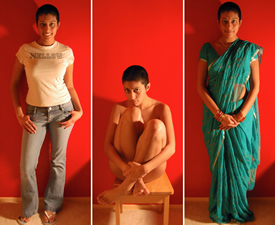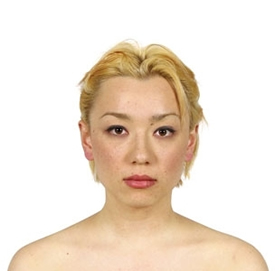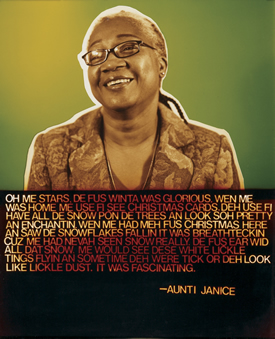
 |
| Chandana Reddy' s three inkjet prints forming a triptych show her life as a woman, an American citizen and an Indian. (Photo courtesy of OUAG) |
By Sarah Malczynski, student writer
The new exhibit, “Revolutionizing Cultural Identity: Photography and the Changing Face of Immigration” opened Saturday, March 8, in the OU Art Gallery. This international exhibition, curated by Claude Baillargeon, professor of art and art history, brings together eleven artists working from a broad range of cultural and conceptual perspectives.
All eleven artists, who live either in the United States or Canada, are descendants of immigrants from around the world. The exhibition focuses on the constant struggle that immigrants and their descendants face having to identify with more than one culture. Each work explores one of two questions: “Who am I, where do I come from and where do I belong?” or “What are you, what is your experience, and where do you see yourself?”
Sara Angelucci, a Canadian-born artist who currently resides in Toronto, comes from a family of Italian immigrants. Her photographs compare the contents of her father’s old wallet to her own.
“I was touched to realize that he carried mementos of loved ones, for I knew that there were few such pictures in my own wallet,” Angelucci said.
 |
|
Kip Fulbeck's collection of thirty digital chromogenic prints emphasizes the diversity of ethnicities in America. (Photo courtesy of OUAG) |
Custodio said, “The work speaks about the tensions surrounding translation, tradition, and place.”
Kip Fulbeck was born in California to a Chinese-American mother and a Caucasian father. His collection of thirty digital chromogenic prints emphasizes the diversity of ethnicities in America.
Describing his work, Fulbeck said, “What you see here are individual Americans as human beings first, defining themselves in their own words.”
Rafael Goldchain, a descendant of Eastern European Jewish immigrants, moved to Canada from Chile. His eight digital chromogenic prints serve as an autobiographical family album.
“The self-portraits are detailed reenactments of ancestral figures. In their specificity they can be understood as acts of “naming” linked to mourning and remembrance,” Goldchain said.
Vid Ingelevics’ collection comprises mail that was sent to his late father. The artist, born in Toronto to Latvian immigrants, noticed a consistent misspelling of his father’s name on his mail and collected 84 examples that he has recorded on a 13-minute DVD presentation.
“I realize that other immigrants have suffered far greater humiliations and injustices in the past so it is not to seek redress or revenge that these excerpts from my father’s collection of misspellings are offered,” said Ingelevics.
 |
|
Christina Lauren Leslie's six chromogenic prints of family members seek to maintain the Jamaican culture that has been somewhat lost to her growing up in Canada. (Photo courtesy of OUAG) |
“I felt a great need to salvage these stories and forever encapsulate them for all to see and hear,” Leslie said.
Yuri Marder’s collection of nine inkjet prints exhibits subjects who exist in a language other than that of their birth, some as political exiles and refugees, some as indigenous exiles in their own homeland, some simply immigrants far from home. The son and grandson of European refugees, Marder currently lives in New York and describes the subjects of his work as “all striving to tell a single story, all hoping to give a little more meaning to the vast context of language, loss, and identity.”
Annu Palakunnathu Matthew, an English native born to Indian immigrants, was raised in India and moved to the United States in 1992. Her collection of three lenticular prints contrasts the lives of three Indian call center workers, whom she calls “virtual immigrants”. Forced to dress and speak like Americans in India, these people are facing a cultural identity crisis in their own country.
“The work explores the magnified cultural dislocation caused by technology's effect on collapsing borders and shrinking distances,” Matthew said.
Wieslaw Z. Michalak, who was born in Poland, currently resides in Toronto. He describes his eight backlit transparencies of cities around the world are “the ultimate expression of human creativity, their morphology [revealing] a great deal about their creators, inhabitants, and immigrants.”
Chandana Reddy, a management information systems major at OU, was born in Michigan to Indian immigrants. Her three inkjet prints forming a triptych show her life as a woman, an American citizen and an Indian.
“We can never strip ourselves completely of any particular cultural determinant and yet it is a struggle to understand one's self as having just one all-encompassing identity,” said Reddy.
Gu Xiong moved to Canada from China in 1989. He said his six ink-jet prints on canvas “explore the cultural tradition and history of Chinese Canadians in order to create a dialogue about their past and present-day experiences.”
Baillargeon commented on the artists’ works, saying, “While the exhibition makes no attempt to survey the broad field of immigration, every effort was made to emphasize diversity. These artists share a common desire to explore shifting notions of identity, whether their own or that of another.”
The exhibition will remain on display until April 13.
Oakland University Art Gallery is located in 208 Wilson Hall and is open Tuesday through Sunday from noon to 5 p.m. During Meadow Brook Theatre performances, the gallery is open Wednesday through Friday from 7 p.m. through the first intermission and Saturday and Sunday from 5 p.m. through the first intermission. For more information, visit the Oakland University Art Gallery Web site or call (248) 370-3005.
 The new exhibit, “Revolutionizing Cultural Identity: Photography and the Changing Face of Immigration” opened Saturday, March 8, in the OU Art Gallery. This international exhibition, curated by Claude Baillargeon, professor of art and art history, brings together eleven artists working from a broad range of cultural and conceptual perspectives. All eleven artists, who live either in the United States or Canada, are descendants of immigrants from around the world. The exhibition focuses on the constant struggle that immigrants and their descendants face having to identify with more than one culture.
The new exhibit, “Revolutionizing Cultural Identity: Photography and the Changing Face of Immigration” opened Saturday, March 8, in the OU Art Gallery. This international exhibition, curated by Claude Baillargeon, professor of art and art history, brings together eleven artists working from a broad range of cultural and conceptual perspectives. All eleven artists, who live either in the United States or Canada, are descendants of immigrants from around the world. The exhibition focuses on the constant struggle that immigrants and their descendants face having to identify with more than one culture.